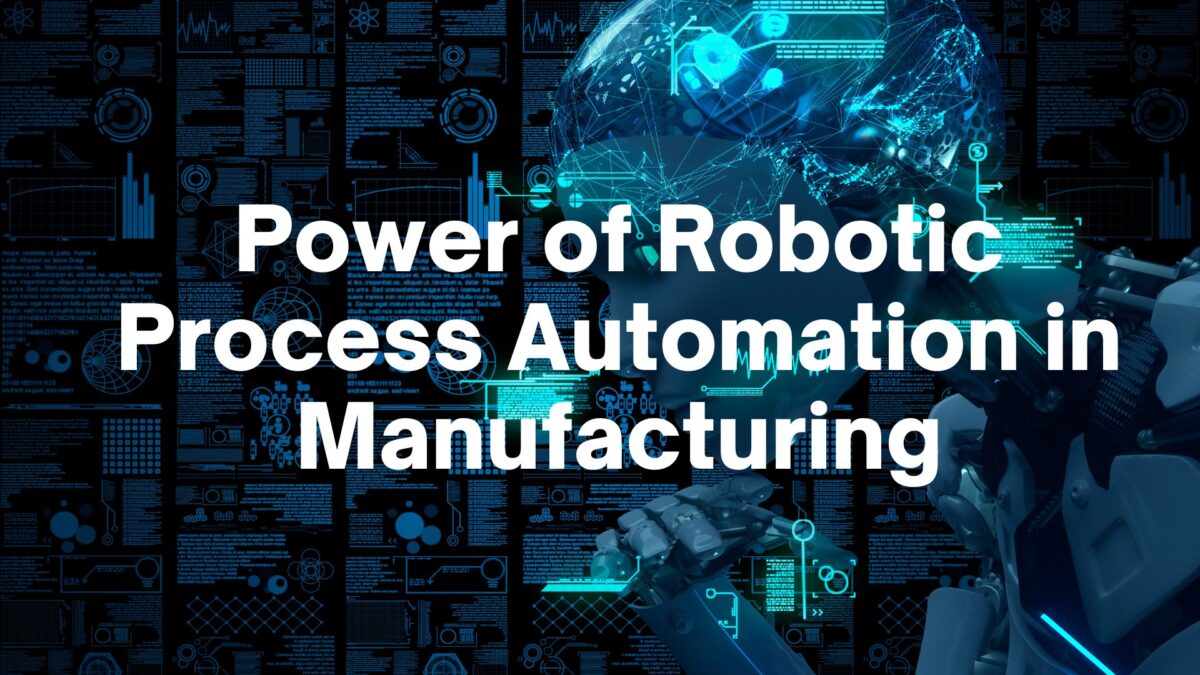This website uses cookies so that we can provide you with the best user experience possible. Cookie information is stored in your browser and performs functions such as recognising you when you return to our website and helping our team to understand which sections of the website you find most interesting and useful.
Power of Robotic Process Automation in Manufacturing

End-to-end process automation can be achieved by combining these technologies and using them as essential enablers. This tactic is widely used by businesses to simplify difficult back-office tasks like communicating with vendors, processing payments, creating reports, and more. We’ll go through some success stories and the part these technologies play in automating the manufacturing process in this article.
According to surveys, 43% of manufacturers currently employ robotic process automation, and a further 43% plan to do so.
Manufacturing organisations are able to accomplish more with less because to robotic process automation. RPA, or robotic process automation services, is changing how businesses in several industries conduct their operations. It enables businesses to automate specific work processes in order to cut down on time spent on time-consuming manual chores and boost focus on completing mission-critical work. Organisations are able to accomplish more with less thanks to RPA, which also enables them to generate financial reports without investing a lot of time in Excel and to carry out customer outreach campaigns without investing a lot of time in a customer relationship management (CRM) programme. RPA has made these kinds of optimisations possible, and businesses are only now beginning to explore all of its potential.
RPA is an important development within Industry 4.0, or the fourth industrial revolution, in general. Industry 4.0 blurs the distinction between the digital and physical worlds. RPA can assist manufacturers in enhancing production, satisfying consumer demands, and continually fostering product innovation—all while reducing costs.
Robotic Process Automation in Manufacturing

Robotic Process Automation in Manufacturing parts can benefit organisations by
- Realise savings within a few months and cost visibility across related parts in a matter of hours.
- Utilise DesignSourceTM cost reductions to support ERP and PLM technology programmes that interact with the same product and supply chain data.
- rationalise the suppliers and part numbers managed
- Reduce costs associated with new product release by driving volume consolidation through reusing from selected suppliers at negotiated prices.
- To capture gains over the short, medium, and long terms through negotiations and engineering changes, create actionable road maps.
- Identification of similar designs can be done more quickly by engineers, freeing up resources for value-added tasks.
- By requiring the use of preferred parts, the organisation can reduce parts complexity management.
- Spend less on materials since procurement can acquire larger quantities of fewer designs.
- Cost savings that vary typically from 4% to 12% of procurement expenditures might amount to tens of millions of dollars yearly for some businesses.
For instance, a life sciences company identified 5% (or around $19 million) in direct material savings that could be attained through short-term price harmonisation, consolidated purchasing, and higher design standards. This was done using RPA-driven components rationalisation.
Similar to this, a major maker of industrial products reduced the cost of off-the-shelf and semi-engineered parts by $530 million by using RPA-driven parts rationalisation to save >$30 million across 18 commodities. The organisation converted 100,000 drawings and data sheets into 600,000 distinct parts with part properties. 30% of the pieces were found to be duplicates by clustering them, and these duplicates will be removed soon. Additionally, recommending preferable parts for search and reuse might eventually lead to a 47% decrease in the company’s overall parts portfolio.
Mobile applications developed using RPA have proven instrumental in streamlining various aspects of manufacturing, from inventory management to supply chain optimization. These applications enable real-time monitoring and control of production processes, empowering manufacturers to make data-driven decisions on the go. By automating repetitive tasks through RPA, such as data entry, inventory tracking, and quality control, mobile applications have significantly reduced human error and accelerated operational cycles.
Robotic process automation benefits for manufacturing
Physical robots have enabled industrial automation in the manufacturing sector. However, manufacturing needs disruptive technology like robotic process automation to enable companies concentrate more on their core competencies and product innovation rather of mundane but essential daily repetitive chores.
To improve process execution speed and accuracy, rule-based procedures can be automated via robotic process automation. Additionally, RPA systems don’t require coding expertise and are simple to use. RPA also easily interfaces with legacy systems already in place without the need for expensive and time-consuming software development.
By selecting a precise set of procedures, businesses can launch a pilot project and get observable, quantifiable outcomes within weeks of implementation.
The manufacturing sector gains from robotic process automation in the following ways:
- Operational cost reduction of up to 40%
- an improved level of process control
- enhanced performance of the workforce
- reduced downtime significantly and improved quality
20 Manufacturing RPA Use Cases that Work
Manufacturers must develop a competitive, effective business strategy that eliminates the need for many workers to complete routine, low-value jobs. Systems can be connected using intelligent automation and RPA, creating new efficiencies for operations across a variety of activities in Robotic Process Automation in Manufacturing businesses.
1. Tracking Production
A approach for measuring, analysing, and enhancing visibility throughout the manufacturing process is production tracking. Manufacturers can provide a near real-time overview of order progress and the ongoing requirement for components or raw materials using clever automation. This aids manufacturers in using lean manufacturing techniques that maximise and optimise limited resources while maintaining low margins.
2. Table of Contents
For manufacturers, keeping an accurate bill of materials (BOM) is essential. The bill of materials (BOM) lists all the raw materials, sub-assemblies, intermediate assemblies, sub-components, parts, and the quantities needed to make each component. Manufacturers may reliably extract product data and replicate human procedures needed to produce an error-free BOM in less time by using intelligent automation.
3. Execution of Regulation
Manufacturers who deal with continual changes in everything from health and safety to cross-border trade legislation need to focus on regulatory compliance. Belgian producer Agristo, a market leader in the distribution of frozen potato goods, is an illustration of how automation may aid in regulation. Agristo wanted to develop a means to swiftly understand new export laws in the wake of the UK’s exit from the EU. Agristo used a digital workforce from Blue Prism to manage the customs forms declaration procedure. Agristo can now correctly complete 1,000 truck customs declaration documents each month thanks to digital workforce.
4. Auditing
Existing procedures, including auditing, can become time-consuming and difficult when factories expand and evolve. Due to Blue Prism’s intelligent digital workforce, the Coca-Cola HR department is able to undertake HR audits in SAP. The beverage juggernaut has automated more than 50 processes across several SAP systems and provides services around-the-clock without the need for additional people.
5. Customer Support and Service
Through effective purchase order processing, attentive customer care, and increased quality assurance, the customer experience can be enhanced. Sysco, the largest distributor of food and food-related items in the world, is an illustration of how intelligent automation may aid in customer service. To help its 600,000 clients, they integrated sophisticated automation into their distribution network. The pandemic significantly strained this network, and Sysco responded by increasing its automation efforts to include more than 60 digital workers. This led to the processing of 6.2 million transactions and the return of over 250,000 work hours to the company.
6. Modernising ERP/SAP
Large manufacturers have historically employed enterprise resource planning (ERP) technologies like SAP to assist corporate operations. However, it can be expensive and difficult to adjust ERP systems to new requirements. Manufacturers may revolutionise their ERP by using intelligent automation and RPA when replacing platforms is not a practical choice. By acquiring the information they require from core systems via bots, procedures may be automated and system functionality can be improved without disrupting legacy IT resources.
7. Operations with SAP/ERP
ERPs are used by modern manufacturers to support business planning and operational management. But since they handle so many different things, manual management of ERPs is frequently difficult and expensive. Automation is becoming more and more popular among businesses as a means of streamlining administration and boosting productivity. A prime example of this is AGCO, a major producer of agricultural machinery with trademarks like Massey Ferguson. Like many users of sizable ERP systems, AGCO discovered that journaling was taking up a sizable portion of the time of its human employees. It need a more intelligent technique to finish journaling that would save overtime expenditures without compromising the correctness of its systems. Currently, many Blue Prism digital employees that support journaling are “managed” by a different digital worker who schedules and manages the rest of the digital team.
8. the replacement of legacy ERP
Many manufacturers are transitioning to SAP S/4 HANA since SAP ERP Central Component (SAP ECC) support expires in 2027, although doing so is challenging and often takes years for many organisations to accomplish. However, the migration procedure gives businesses a chance to critically evaluate their current ERP plans and consider how automation may advance them along the road to digital transformation.
9. Data Management and Migration
By organising and validating data movement across databases, intelligent automation facilitates ERP migrations. Hovis, a British bakery and wheat milling company, was struggling with the complexity of numerous dissimilar systems and processes. Large-scale system improvements would be time- and money-consuming to implement. They used a solution that relied on people to connect disparate systems—manually entering data to fill in the gaps. Hovis has virtually eradicated errors in master data and scheduling updates by using clever automation.
10. the development of digital supply chains
The manufacturing environment of today is made up of separate silos. It can be difficult to extract crucial data from all of these silos and from older, disparate systems. Additionally, gathering this data can necessitate a lot of laborious manual processing and additional staff. Manufacturers can de-silo processes using a digitised supply chain and establish a data lake/process mining area where valuable insights can be obtained.
11. Demand Chain Management
Effective digital integration and linkages are required for supply chain demand forecasting across numerous geographies. Supply chain silos are broken down by automation, which also gives information, ensuring that commodities and materials are available where they are needed. Norsk Stl, a well-known producer of metals and steel, demonstrated the potential of RPA and intelligent automation in supply chain demand planning. A team works across all of their operations to determine the most efficient way to produce steel products in order to satisfy client deadlines and reduce waste. A digital employee receives a daily estimate of the maximum workload for the plants from production planners. Before the morning shift begins, the digital worker draws up a manufacturing plan for the plant and enters the accepted orders for steel goods into their ERP. They also choose the best production strategy.
12. Logistics management
On the production floor, machines record crucial data, but it’s frequently locked away in difficult-to-access systems. Intelligent automation offers a quick, flexible approach to connect data with other systems and retrieve it, which saves time and money. Manufacturing companies can anticipate improved freight management procedures such freight accounting, route optimisation, and freight claim management.
13. Inventory Control
Digital workers at chocolate producer Hershey conduct a routine every morning before the workday starts that detects every product with a mislabeled label and alerts supply centre and supply planning staff so they can promptly and properly rectify inventories. In comparison to when the process was controlled by people, digital workers are significantly more accurate and consistent because they handle the more tedious checks between several apps.
14. Predictive Maintenance and IoT
Rules-based systems, which frequently produce false positives and are less efficient, are frequently used to give predictive maintenance solutions. Advanced machine learning combined with RPA makes it possible to detect defects considerably more accurately in advance, increasing equipment uptime while lowering operational costs.
15. Enhancing Back-Office Operations
Although manufacturers are skilled at integrating robotics into shop floor procedures, the back office still frequently relies on people to complete monotonous duties, such credit and collections management. However, given that estimations indicate that up to 70% to 80% of these operations can be securely automated, there are many chances to improve performance without spending more money.
16. Contract Administration
Manufacturers can use RPA bots to generate, amend, and notify them of supplier contracts. This gives staff the authority to proactively renew contracts with suppliers and guarantees that there is enough time for renegotiation.
17. Processing Invoices Automatically
Manufacturers may lower errors, increase productivity, and enhance customer experiences by intelligently automating operations like invoice production, verification, and processing.
18. Order Control
Manufacturers can simplify and automate internal operations by streamlining order management. By doing this, it is ensured that the appropriate data enters operational systems like anticipating demand and digital supply chains.
19. Management of Credit and Collections
In order to decrease bad debt, lower associated expenses, and enhance the end-user customer experience, collections operations must be streamlined. Manufacturers can gather consumer data, such as credit records, using intelligent automation prior to initiating collection action.
20. Account adjustments
Manufacturers can use intelligent automation to simplify customer service data input across systems or enable self-service. By doing this, businesses can prevent costly errors and workarounds and guarantee that they always have the right customer data in place and that it flows through every operation affecting those consumers.
21. Onboarding of Suppliers
The process of conducting compliance inspections and obtaining data to onboard vendors is time- and resource-consuming. Additionally, as various teams frequently complete tasks in succession, the resources required to prepare a new supplier for business may take longer than expected. Instead, producers can teach digital employees to look for pertinent information as part of a parallel, quick process.
22. Reporting on Performance
To show compliance with SLAs and regulatory performance, digital workers can create reports. ABB, a major producer of industrial equipment in Switzerland, uses intelligent automation to gather and produce more than 200 reports every morning. This gave employees in more than 25 nations the knowledge they needed to increase their performance.
23. Quote Control
Manufacturers can instantly generate on-demand estimates thanks to intelligent automation, which reduces wait times and enhances the client experience. To manage its crucial quoting process for revenue generation, AGCO implemented intelligent automation. Each quote used to need a significant amount of staff time to complete. In order to give its team more time to concentrate on negotiating better contracts, AGCO intended to streamline the procedure. A digital worker now reads the email, retrieves the data, updates the systems, and provides the quote in response to a request for a quote. The crew now has more time to devote to important activities because to the hundreds of hours saved.
RPA Implementation
Individual bots or standalone programmes that carry out individual tasks automatically are the most popular way to apply RPA. You can use a desktop or web-based programme to access the bot. A server that manages a group of bots inside a division or throughout the entire organisation can also be implemented by organisations. The individual bot method is appropriate when only a few bots are utilised, however the server-based approach is a more robust system that is often used when there are more bots throughout an organisation that need to be maintained centrally.
Any organization’s worry about the price of an RPA solution is dependent on these variables:
- Complexity
- quantity of bots
- Time to create and put into action
- Customization level
It can be expensive to implement an enterprise-wide RPA solution that uses hundreds of bots. However, a simpler solution that uses no more than 10 bots can be put into place quickly and at a low cost. RPA solution providers frequently have a library of pre-built bots that may be swiftly customised and implemented without the need for a new bot to be created. The price will keep dropping as the RPA market gets more developed.
The important steps for deciding whether an RPA solution is appropriate are listed below:
- Identify the manual chores that need the most time and effort.
- Determine the important processes’ bottlenecks, especially the manual tasks.
- Start a prototype project to complete a high-value discrete activity that can be useful right away.
Conclusion
RPA will become more crucial as manufacturers transition to Industry 4.0. It gives businesses a novel, engaging way to enhance productivity while enhancing job happiness among staff members. By enabling people to concentrate their time and energy on more high-value and meaningful work, RPA solutions have grown to be a frequently used technique for improving numerous aspects of an organization’s operations. It has aided businesses in dramatically increasing productivity while using fewer resources, lowering errors, raising employee job satisfaction, and better guaranteeing that deadlines are met. With the use of IT resources and relatively little capital expenditures, these advantages have been made achievable. RPA is a viable alternative for cutting down on the amount of time spent on repetitive, manual tasks, while not being appropriate for all types of work.



